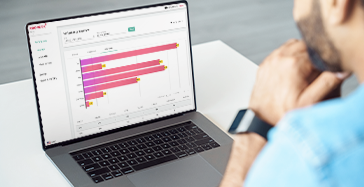Thought Leadership
Generate More Revenue by Looking at Your Hotel Like An Owner

Table of Contents
How to get creative with hotel revenue-generating ideas?
Why should you turn to upselling as a solution for hotel revenue-generating ideas?
Why do you need to constantly consider new hotel revenue-generating ideas?
Wondering about hotel revenue-generating ideas that will offset ‘sunk costs?’ Look to ancillary revenue-generating ideas like room type upgrades, and early check-in or late check-out upselling.
In economics and business decision-making, sunk costs refer to costs that have already happened and cannot be recovered. These costs are different from ongoing costs that are spent on salaries, subscriptions, insurance, etc. The concept is important because sunk costs will stay the same regardless of the outcome of any action or decision you make in the future.
In the area of hotel costs, the cost of construction (and/or hotel purchase) falls into the category of sunk cost. Let’s think of a hotel from the owner’s perspective. They want to maximize the value of the real estate they have purchased – every inch of it. Every day, the goal is to turn the invested dollars into something of greater value. And the potential revenue that space in the hotel might earn is gone forever once it is empty.
You only have one chance to rent a hotel room for the 4th of July. After the end of the day, the product instantly goes bad. You have to take it off the shelf and display a new one called “July 5th.”
How to get creative with hotel revenue-generating ideas?
The problem occurs when hoteliers fall in love with their Room Types and forget that, every day, the goal is to sell as much of the space as possible to put against the sunk cost of the purchase of the hotel. Any extra dollar that you can make on the hotel’s space – any revenue-generating idea that brings in more money per room regardless of what name you have given it – ensures that you will not lose the opportunity to make money.
The concept of room types is just something created to help with pricing. The cost of a hotel room is more or less fixed. Revenue management staff sets room rates to cover all fixed costs and then generate additional profit.
In acquisition strategy, tiered pricing helps maximize exposure to a wider audience of potential buyers. However, once the guest reservation is acquired, the difference in room types is essentially meaningless. (Note: with accurate Forecasting, there is a point where a hotelier can predict which rooms may have a potential providing zero revenue against the hotel’s sunk cost for a given night. At that point room type distinctions are also meaningless.)
Once booked, you simply have a set of guests who are paying various amounts to stay in various spaces in the hotel’s real estate. The goal is, then, to increase the total dollars earned for that night.
How do hotels generate revenue?
Traditionally, hotel operators have been conditioned to sell ancillary services like:
- Dining
- Spa
- Golf
- and entertainment
in the hope of generating extra revenue. While these services can make for a great experience, they are notoriously low margin offers.
Hotels need to think like hotel owners when considering revenue-generating ideas – what asset makes the largest profit?
Why should you turn to upselling as a solution for hotel revenue-generating ideas?
For most hotels, the answer to ‘Where can I capture more revenue?” is space! If you don’t sell that space, it’s lost money. If you don’t maximize the space, it’s lost money.
The easiest way to upsell and generate ancillary hotel revenue is to provide room upgrades. The rooms are present, need no additional arrangements, and have the highest margin.
“When you sit down to do the math on the potential additional revenue to be generated (even for hotels with minimal upsell opportunities), it becomes instantly clear that the effort can easily generate a significant ROI,” says Doug Kennedy, President of the Kennedy Training Network.
But it’s not simply about upgrading. It needs to be offered at the right price.
“Upgraded accommodations, if offered at all, are at rack rates. The result is that the additional cost to upgrade does not justify the value received,” continues Kennedy.
In times of low occupancy, hotels have the potential to sell their premium rooms below the rack rate. For example, suppose a hotel has calculated that their average room rate for a Standard room to be $200 per night, of which $25 covers fixed costs such as cleaning, utilities, etc. And, the average room rate for a Suite was $300, of which cleaning, etc. costs $30. Selling a guest an upgrade to a suite for an additional $25 would give the hotel a margin of $195 – taking into account the $30 for cleaning the suite.
Refusing to offer the suite, or simply not offering it, equates to a lower margin of $175. In times of low occupancy, where premium hotel rooms are unlikely to get sold for the length of stay (LOS) of the arriving guest, the hotel should ignore the normal premium room rate, ignore the fact that it represents more value, and instead recognize that premium hotel rooms are hotel space that you can get revenue from.
Why do you need to constantly consider new hotel revenue-generating ideas?
Every additional dollar made through an upsell or upgrade is an almost 100% addition to the margin and contribution of the hotel.
All hotels need to make money. For a guest, a room could mean privacy, comfort, cleanliness, convenience, and security. But for a hotelier, it’s a source of revenue like any other product offering.
Pre-pandemic, most hotel operators struggled with revenue-generating ideas when room occupancy was low. With the onslaught of Covid-19, the constant decrease in occupancy and revenue per available room has imposed unprecedented challenges to hotel owners and operators. Putting successful hotel revenue-generating strategies in place, such as upselling, can be a great resource to increase your revenue per booking and mitigate losses.


